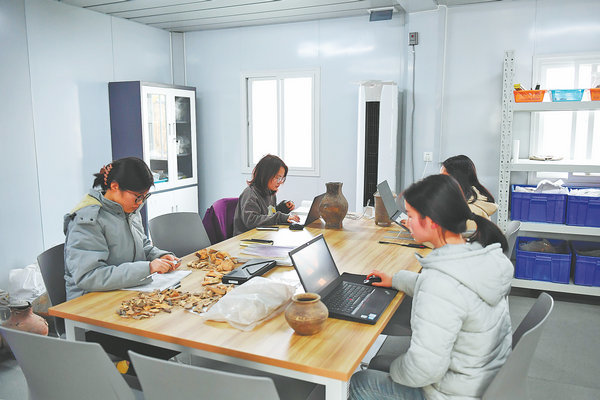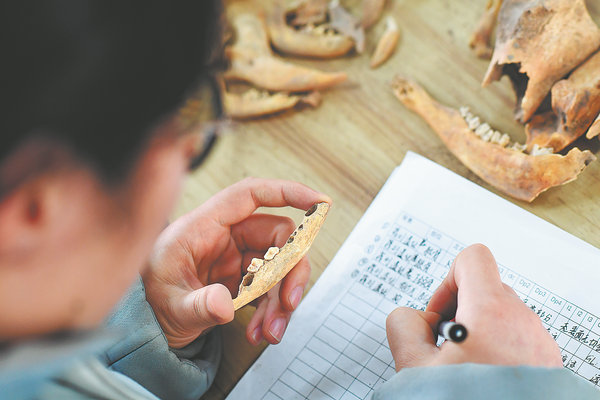Women Make Their Mark in Archaeological Field
 |
| Members of the archaeological team. [Xinhua] |
Hunching over with shovel in hand, 30-year-old Zhu Yingpei is at work in a newly excavated tomb in Xianyang in Northwest China's Shaanxi Province. She is accompanied by a group of women archaeologists.
Pointing to bones and relics in a coffin, Zhu says the tomb belonged to an ordinary person during the Western Han Dynasty (206 BC-AD 24). "We cannot find the occupant's name, but we can catch a glimpse into the daily lives of people over 2,000 years ago."
Digging in soil, carefully brushing away dust, revealing the appearance of ancient artifacts, and meticulously documenting findings constitute the daily tasks of the Jinghe River archaeological team from the Shaanxi Academy of Archaeology.
For team leader Zhu, archaeology intertwines seriousness with a sense of romance. She vividly recalls excavating a tomb adorned with pottery figurines frozen in dancing gestures, as well as discovering pottery ware like kitchen utensils and vessels for alcohol.
 |
| Wang Xiaojuan restores a colored rider and horse artifact. [Xinhua] |
"Like modern people, our ancestors also used to dance and entertain themselves," she says, adding that archaeology and research is like reading a book.
Established in 2020, the team has 17 members, of which 11 are women with an average age of less than 30. The team has worked on excavations in more than 40 archaeological projects.
One of its members, 26-year-old Guo Jie, has mastered the skill of identifying gender and estimating the approximate age at death through human remains. She says anthropological research has opened a new world for her. "Through the comprehensive study of human bones, we can explore health and disease, genetic relationships, and the social customs of ancient people."
Guo adds that despite the demanding nature of fieldwork and the relative lack of recreational activities, the endeavor is fulfilling as it contributes to filling in historical details.
 |
| Members of the Jinghe River archaeological team from the Shaanxi Academy of Archaeology document their finds. [Xinhua] |
In her spare time, she likes to visit museums and places with historical relics. "At times, we find ourselves compelled to offer explanations to visitors or correct inaccuracies on display boards," Guo says.
"The profession is addictive," says another team member Wang Hongying, who specializes in animal bone identification. She illustrates her point with examples, noting there are frequent cut marks on the bone remains of pigs, cattle and sheep, but little evidence of such marks on dog bones. This suggests that the former were likely used as a food source, while the latter served as companions.
According to Chong Jianrong, head of the Shaanxi Academy of Archaeology, an increasing number of women students have chosen archaeology as their college major and joined the academy in recent years.
 |
| Zhu Yingpei works on site. [Xinhua] |
"Perhaps, more attention has been paid to archaeology, making this once little-known and niche discipline more popular," says Chong. "It is about teamwork, and our women colleagues actively conduct field research and work for the protection of cultural relics."
Zhu says she hopes to be wielding a shovel and walking in fields even when she is in her 80s. "We are content as long as we keep pursuing and exploring new knowledge."
 |
| Wang Hongying documents excavated animal bones. [Xinhua] |
(Source: China Daily)
Please understand that womenofchina.cn,a non-profit, information-communication website, cannot reach every writer before using articles and images. For copyright issues, please contact us by emailing: website@womenofchina.cn. The articles published and opinions expressed on this website represent the opinions of writers and are not necessarily shared by womenofchina.cn.








.jpg)

 WeChat
WeChat Weibo
Weibo 京公网安备 11010102004314号
京公网安备 11010102004314号